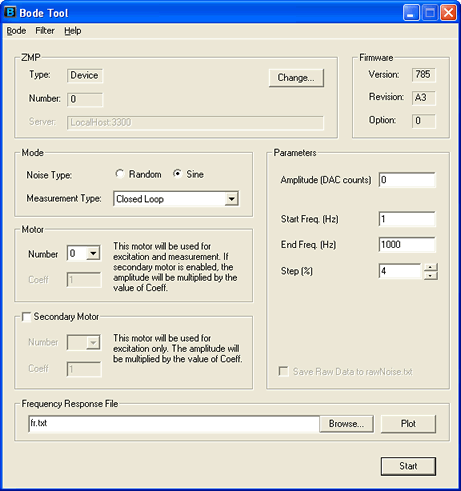Running a Sine Sweep
To make a sine sweep measurement of the system, select Sine Sweep as the Noise Type.

Before performing a sine sweep test, several parameters must be set:
Measurement Type
Amplitude
Standard Firmware:
— Motor Number
— Secondary Motor Number and both coefficients (optional)
MechaWare Firmware:
— Model number of downloaded model
— Active noise block (Custom or User Buffer)
or
— Active motor block
(Closed or Open Loop)
Note: Start Frequency, End Frequency, and Step percentage must also be set as described below.
Start Frequency
This is the beginning of the sine sweep range. Frequencies that are below 1 Hz suffer from sine signal generation artifacts, which typically result in rough motion during testing. However, the data collected should only be slightly affected. Most systems controlled by an ZMP will have an ideal response below 1 Hz.
End Frequency
This is the ending frequency of the sine sweep signal. The practical upper limit is the Nyquist frequency (1 / 2 * servo sample rate, default sample rate = 2000 Hz). While any data collected above the Nyquist frequency is not recommended, you can still test above this frequency. However, an upper limit of 20,000 Hz is enforced.
Step Percentage
The sine sweep is not a smooth ramping of a sine test signal. Rather, it is a series of sine signals that are momentarily constant in frequency and are stepped in frequency between adjacent frequencies. The entire sine sweep signal is continuous in time (i.e. no discontinuities in time). The size of the adjacent frequency steps are set by Step Percentage. Using a small Step Percentage (< 3%) will result in more frequency response collected, finer resolution of that data, and a longer test. A high Step Percentage (> 3%) will result in less frequency response data collected, coarser resolution of that data, and a shorter test. If the step percentage is too high, resonance data can be distorted, or miss a resonance altogether. A step percentage a 4% seems to be a good starting point for most systems. For example, if you had a Start Frequency of 1 Hz and a Step Percentage of 4%, you would get the following sine frequencies: 1.0 1.04 1.0816 1.124864 etc.
Previous | Next
|
